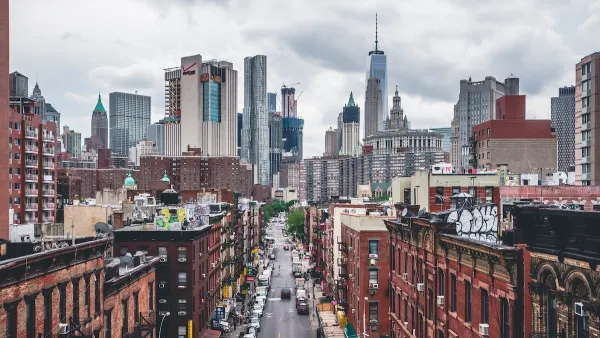What is the apt metaphor for a city? Machines? Insect colonies? In a new paper, physicist Luis Bettencourt says that if we look to the function of cities we find that they're essentially social reactors that obey universal mathematical parameters.
What is the best way to conceptualize a city, asks Emily Badger. "Bettencourt, in a paper published today in the journal Science, finally offers up an answer that borrows a bit from physics, economics, sociology, biology and a handful of other disparate reaches of science. We can never get the analogy quite right, he says, because cities are a thing that is found nowhere else in nature."
"At their most fundamental, cities are not really agglomerations of people; they’re agglomerations of connections between people," explains Bettencourt, a physicist with the Santa Fe Institute, in his paper. "All of their other properties – the roads we build to reach each other, the density required to do that, the economic products and ideas we create together – derive from this fact."
"Cities, Bettencourt has concluded, are a 'special kind of social reactor.' And, as such, they all evolve according to a small set of basic principles that can be used to predict the average social, spatial and infrastructure properties of any metropolitan place," says Badger. "Bettencourt’s theoretical framework suggests that a kind of optimal city exists when we have the most social interaction – and social and economic output coming from it – with the least cost of connecting people and goods and ideas to each other."
"The idea that cities are governed by some universal rules of math may make it sound like the urban planner has little control. But, in fact, Bettencourt sees the planner’s job to try to steer cities toward that optimal point (G*) on the above graph. Beyond that point, the number of social interactions in a city can still grow, but the cost of them rises faster than the benefit."
FULL STORY: Scientific Proof That Cities Are Like Nothing Else in Nature

Analysis: Cybertruck Fatality Rate Far Exceeds That of Ford Pinto
The Tesla Cybertruck was recalled seven times last year.

National Parks Layoffs Will Cause Communities to Lose Billions
Thousands of essential park workers were laid off this week, just before the busy spring break season.

Retro-silient?: America’s First “Eco-burb,” The Woodlands Turns 50
A master-planned community north of Houston offers lessons on green infrastructure and resilient design, but falls short of its founder’s lofty affordability and walkability goals.

Test News Post 1
This is a summary

Analysis: Cybertruck Fatality Rate Far Exceeds That of Ford Pinto
The Tesla Cybertruck was recalled seven times last year.

Test News Headline 46
Test for the image on the front page.
Urban Design for Planners 1: Software Tools
This six-course series explores essential urban design concepts using open source software and equips planners with the tools they need to participate fully in the urban design process.
Planning for Universal Design
Learn the tools for implementing Universal Design in planning regulations.
EMC Planning Group, Inc.
Planetizen
Planetizen
Mpact (formerly Rail~Volution)
Great Falls Development Authority, Inc.
HUDs Office of Policy Development and Research
NYU Wagner Graduate School of Public Service




























